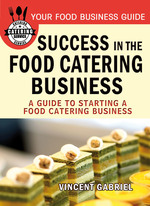Purchase the ebook for easy and immediate reading.
Purchase the print book for easy reading (3rd party vendor).
Purchase the audiobook for easy listening.
 This book marks the fact that food catering has gone mainstream. At one time associated with organizers of seminars and conferences as a means of bonding the attendees of the event or to provide convenience so that each person who attended did not have to look for his own food. The food catering business is very closely connected with the industrial economic development of the Asian economies that underwent transformation in the late 1940's and continues up to today. The food provided at the seminars were arranged in three groups. A coffee break was held in the morning with a range of light snacks that included a major starch like fried rice or fried noodles. The lunch menu was clearly more extensive with a soup, a vegetable dish, a meat dish, a fish dish and a dessert. Care had to be taken to avoid offending anyone. Pork was not allowed nor was beef. The only meat served was chicken and it came in different forms: fried, roasted, boiled, with sweet and sour sauce, or with black pepper sauce or simply hot and spicy. The last meal was the tea break. In a way this meal was a milestone because the people of the Asian economies never had an afternoon break as they were expected to go home at 5 pm and have a meal at home at 6 pm. With the tea break it became a custom to have dinner or the evening meal later at 7 pm.
This book marks the fact that food catering has gone mainstream. At one time associated with organizers of seminars and conferences as a means of bonding the attendees of the event or to provide convenience so that each person who attended did not have to look for his own food. The food catering business is very closely connected with the industrial economic development of the Asian economies that underwent transformation in the late 1940's and continues up to today. The food provided at the seminars were arranged in three groups. A coffee break was held in the morning with a range of light snacks that included a major starch like fried rice or fried noodles. The lunch menu was clearly more extensive with a soup, a vegetable dish, a meat dish, a fish dish and a dessert. Care had to be taken to avoid offending anyone. Pork was not allowed nor was beef. The only meat served was chicken and it came in different forms: fried, roasted, boiled, with sweet and sour sauce, or with black pepper sauce or simply hot and spicy. The last meal was the tea break. In a way this meal was a milestone because the people of the Asian economies never had an afternoon break as they were expected to go home at 5 pm and have a meal at home at 6 pm. With the tea break it became a custom to have dinner or the evening meal later at 7 pm.We have been providing authors and small presses with ebook publishing and book marketing services since 2010. We offer ebook publishing (creation, formatting, distribution), print on demand services, audiobook creation, editing/proofreading, book/author websites, and book marketing and promotion services. Please let us know how we can help you!